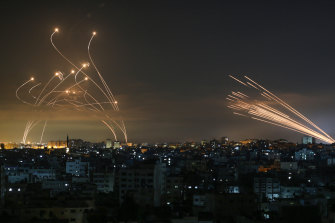Your fast guide to the high-tech shield that’s changed the Israeli-Palestinian conflict.
The lights split apart the night sky over Israel and Gaza – rockets and answering interceptor missiles exploding overhead in a shower of sparks, like alien warships doing battle. The violence between Israel and Palestine is now the worst seen in years – air strikes from Israeli warplanes have killed hundreds of Palestinians in densely populated Gaza, while a barrage of rockets fired by Gaza’s militant group Hamas is testing Israel’s Iron Dome missile defence shield.
Rockets are fired in both directions in the early hours of May 14.Credit:AFP
What’s an Iron Dome?
Israel’s Iron Dome is a mobile defence system designed to take out short-range rockets fired up to 70 kilometres away, no matter the weather. It was brought in a decade ago with US funding help – a big-tech solution to the low-tech rockets built by Hamas in the streets and tunnels of Gaza, and one part of Israel’s sweeping security apparatus of surveillance drones and checkpoints that monitor the 2 million Palestinians blockaded inside Gaza.
But it’s not really a giant dome over Israel, right?
No. The dome is actually a roving group of “batteries” or equipment units – radars, computers and missile packs – on wheels. Radars listen for incoming rockets nearby and feed that data to the computers to analyse the rockets’ trajectory and model. If they’re headed for uninhabited land, the AI won’t recommend taking a shot. But if a rocket is on course for people or property, then an interceptor missile will be fired to explode just in front of it, taking it out in the fireball. The units, including the interceptors, move around to cover more ground and keep their location secret.
Does it work? And has it changed the conflict?
Yes, and yes. Israel and the local companies who designed the dome claim it’s 90 per cent effective. While experts put that success rate at about 80 per cent, it’s still considered the most advanced low-range rocket shield in the world. The dome has largely lifted the shadow of Hamas rocket strikes from Israeli life as the conflict over the occupied territories stretches on. But it has not stopped Israel launching air strikes of its own on Gaza’s captive population. In the current violence, people have been killed on both sides, including children. But, with fewer strikes making it through Israeli air space, Israel’s death toll is much lower. “The number of Israelis killed and wounded would be far higher if it had not been for the Iron Dome system,” said Lieutenant-Colonel Jonathan Conricus, an Israeli military spokesman.
What if you fire lots of rockets at once?
That’s exactly what Hamas and other groups in the region have been trying as they look to find the Iron Dome’s so-called “saturation point”, where it is overwhelmed by rockets. Until May, the biggest test for the dome was in 2014, when Hamas fired some 1500 rockets. This time, Hamas had already fired more than 3000 as of May 19. Many were off target, a handful got through but the Israeli military still says the dome is proving about 90 per cent effective.
Will Israel run out of interceptors?
The dome only fires when it has to, but its interceptors are not unlimited, with each costing somewhere between $US20,000 and $US100,000. Hamas is estimated to have thousands of rockets – enough, it says, to keep the bombardment going for some time.
Do other countries have anything like Iron Dome?
The dome is distinct from the anti-nuclear weapons systems designed to take out warheads coming in fast from further afield (though some have likened it to former US president Ronald Reagan’s infamous “Star Wars” plan for a missile defence system). Many countries looking to counter short-range threats have been considering adopting Israel’s dome, including Saudi Arabia, India and the United Arab Emirates, and analysts say its success so far in the face of this increased bombardment will likely encourage more interest.
What’s next?
Iron Dome already uses AI to analyse fast where rockets will fall and target missiles. But Israel is also looking to deploy an energy beam weapon soon. “Iron Beam” would shoot down rockets using lasers, cutting costs and likely performing better against the more sophisticated weapons of Hezbollah in Lebanon, should significant conflict break out with it again.
If you'd like some expert background on an issue or a news event, drop us a line at [email protected] or [email protected]. Read more explainers here.
Most Viewed in World
Source: Read Full Article



